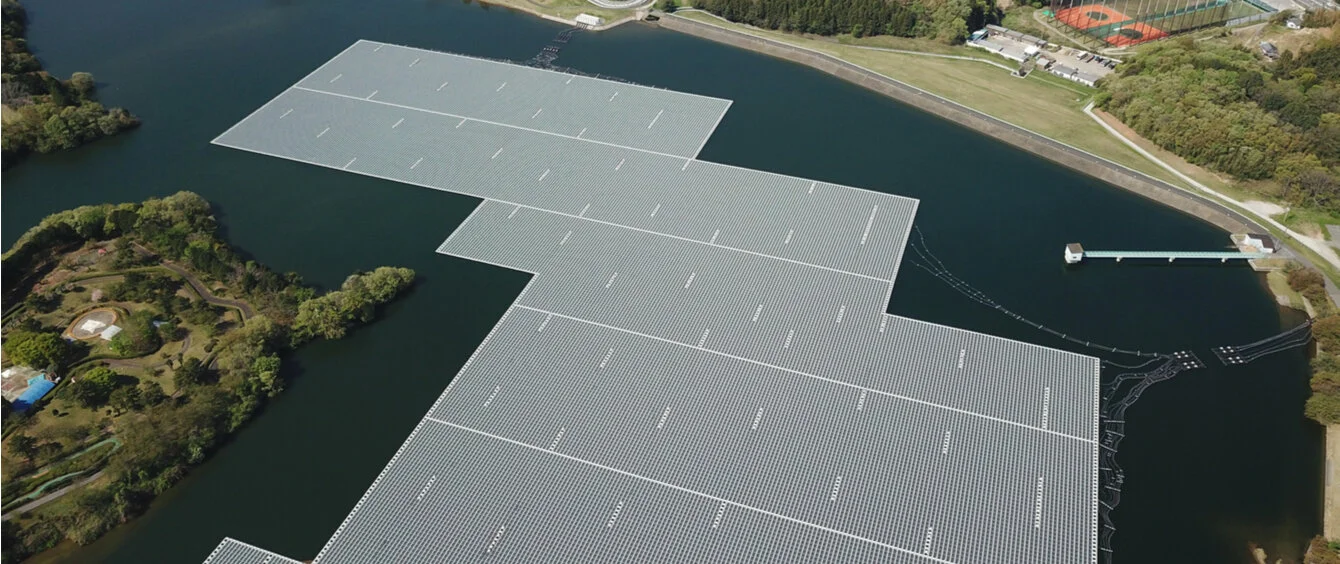Floating solar farms have two major advantages. Firstly, unlike rural constructions, they do not take up valuable land, thus enabling them to avoid competing with agriculture or other types of use. And secondly, they are able to generate more electricity to boot, as the water is used to cool the arrays, which increases their efficiency. Sadly, the price tag for installing such floating farms is notably higher than for ground-mounted systems. Until recently, it was mainly countries in Asia – particularly densely populated nations such as Japan and China – that relied on this technology. However, floating solar farms are now also being built in Europe. Reason enough for en:former to present an overview of the technology and individual projects.
According to a detailed report in Handelsblatt (in German), countries all over the world are investing in this floating technology. Last year, researchers at the National Renewable Energy Laboratory (NREL) counted more than 100 projects. It is thought that floating solar systems harbour considerable potential for the near future. They are likely to “become increasingly important moving forward, especially in countries with high population density and access to multiple bodies of water”, Carsten Körnig, Managing Director of the German Solar Industry Association (BSW), told Handelsblatt.
The business newspaper also highlights the technical advantages of floating solar farms: The water makes for cooler surroundings in summer. “This makes it possible to generate additional power during sunnier months,” Harry Wirth, Head of Photovoltaics at the Fraunhofer Institute for Solar Energy Systems (ISE), explained to the publication. The rule of thumb here: One percent more electricity yield per two-degree drop in operating temperature.
Solar expert Wirth also sees the potential for this technology in Germany, citing lignite mining areas as a possible location for their construction. In Germany, opencast mining has consumed around 1,773 square kilometres of land so far – around three times the size of Lake Constance. “And large swathes of it were or are still being flooded,” Wirth relayed to the newspaper. A look at the numbers shows that it would be possible to install floating PV arrays with a total capacity of 50 gigawatts – slightly more than the capacity already installed in Germany.
Opencast mining in Germany has consumed a total area of around 1773 square kilometres. Theoretically, floating solar systems with a total capacity of 50 gigawatts could be installed there
Plans for a farm in the former opencast mining area
Energy supplier innogy could be the first to embark on this journey. Rheinische Post (in German) reports that the company is planning on building a floating solar power plant in a former opencast mining area in North Rhine-Westphalia. On Lake Neurath, to be precise, which grew from the hole left behind by the Neurath North opencast lignite mine in the Rhenish coal-mining region.
The floating photovoltaic system is to be built on the lake for demonstration and testing purposes. “We can use existing infrastructure,” Thorsten Miltkau, Solar Project Manager at innogy, explained to Rheinische Post. A photovoltaic system – the largest built in Europe at the time – has been generating electricity on the shores of the lake since 1991.
Germany’s largest plant on an quarry lake
In Baden-Württemberg, they are a couple steps ahead. Germany’s largest waterborne photovoltaic installation, based on operator statements, has been producing electricity since the summer on a quarry lake in Renchen (Ortenau District). As reported by the newspaper Zeitung für kommunale Wirtschaft (in German), among others.
The floating solar farm is expected to generate around 800,000 kilowatt hours of electricity per year, which will be primarily used to power the machinery of a gravel plant. As a comparison – this corresponds to the annual consumption of almost 300 households. The modules need in excess of 8,000 square metres of space and thus cover around two percent of the 43-hectare lake. With around 150 quarry lakes along and around the Rhine, investors have noted numerous promising locations for this floating technology.
46,000 modules with a peak output of 17 megawatts
Yet these numbers pale in comparison to those of Europe’s largest floating solar farm. Located in the south of France, near the city of Orange, the energy supplier Akuo Energy has built the O’MEGA1 plant on a quarry lake and online magazine Edison (in German) has taken a closer look at the project: 46,000 modules spanning an area larger than 17 hectares (approx. 25 football pitches) boast a peak output of 17 megawatts. According to the company, the electricity produced would be enough to cover the annual consumption of about 4700 homes.
How to install a floating solar system - an example from Great Britain
The online magazine has also looked into the technical requirements. Given the proximity of the electricity to the water alone, the cables and modules need to come equipped with a special insulation that lasts for more than 20 years. Robust, double-glass surfaces, for example, are used for the modules, and underwater cables similar to those used in offshore wind farms are used for transmitting electricity. As such, floating solar technology is currently somewhat more pricey than solar power, generated via free-standing systems.
Nevertheless, experts expect floating solar systems to become ever more crucial for securing the energy supply of the future – particularly in countries where land is a commodity. Another example: At the end of the year, a solar farm which has been constructed on an Alpine reservoir in Switzerland is to be connected to the grid, as reported by NZZ (in German).
Photo credits: © dreamnikon, shutterstock.com
